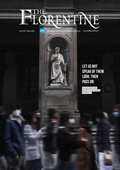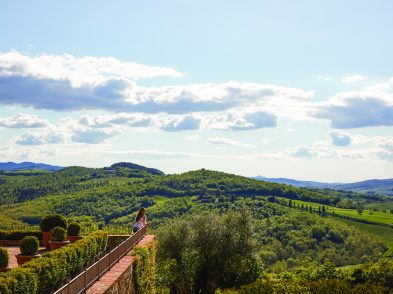Those who return to Florence this year will find a city transformed. The extended lockdown offered the opportunity to carry out important works of maintenance and restoration across the centre, from expanded bike paths and newly paved riverways, to redesigned admissions offices and distancing protocols implemented in our top galleries and museums.
One example of what can be accomplished with enough time behind closed doors can be found in the Baptistery, where the fabulous late medieval mosaics have been under meticulous restoration since 2017. The project has picked up speed whilst the building has been closed to the public, and the works are now past the midway point. The Baptistery’s octagonal interior presents a glorious 14th-century cycle of prophets, bishops and cherubs, running along the elevated women’s gallery (or matroneum), set in exquisite gilded mosaics. Further up are wonderfully realised stories from Genesis and the lives of the Virgin and Christ rendered in mosaics applied to the domical vault from the 13th century. As a whole, the Baptistery interior represents the largest and most important example of mosaic decoration in Tuscany. It is a wonder to behold in its newly restored state. These mosaics impacted generations of Florentines, including Michelangelo Buonarroti and Dante Alighieri (who was baptized there) with their arresting images of infernal damnation and celestial splendour. One wonders whether we ever would have had a ‘Divine Comedy’ or Sistine Ceiling and Altar wall without these awe-inspiring narratives handed down to the citizens of Florence so many centuries ago. Rightfully a source of local pride, the Baptistery will once again be accessible through a general admission ticket along with the Duomo, Campanile and Museo dell’Opera del Duomo this spring.
The streets and piazze of Florence are still relatively empty, but the crowds of visitors are destined to return eventually. If this year’s events have left you longing a more solitary form of exploration, an afternoon in the Tuscan countryside delivers an enchanting mix of medieval ingenuity and natural beauty. The former Cistercian abbey of San Galgano, with its open-air nave and idyllic setting, preserves the memory of Galgano Guidotti, canonized in 1185. Nearby, his tomb in the small Rotunda di Montesiepi includes a curious artifact connected to the saint’s life and legend. Reminiscent of the Arthurian tale of the sword in the stone, you can see the hilt of an iron broadsword emerging from the exposed bedrock. Legend holds that a vision of St. Michael Archangel led Galgano to this place, where he encountered the 12 Apostles and the Creator. He immediately committed himself to a hermetic and contemplative life. Unable to fashion a wooden cross to mark the holy location, Galgano drove his own sword into the ground, thus renouncing his previous role of warrior in a reversal of the Excalibur narrative. Following his death, Cistercians from Volterra constructed the rotunda, preserving our own Tuscan ‘sword in the stone’ and this episode is among the scenes frescoed by Ambrogio Lorenzetti of Siena in the tomb’s interior.
Whilst you are waiting for the opportunity to visit Florence and Tuscany again, the British Institute of Florence offers wonderful opportunities for virtual exploration with its renowned online History of Art courses. April is Medieval Month, so why not drop in to learn more about the Baptistery, San Galgano and a host of other pre-Renaissance art stories.
Two courses begin on 12 April: Medieval Florence and the complementary Super Tuscans, which looks at what was happening in the rest of Tuscany.
More details and registration: www.britishinstitute.it/history-art-italian/history-of-art

This article was published in Issue 276 of The Florentine.










